Gas Turbine Cogeneration System
(Kawasaki GPB Series)
A cogeneration system drives a gas turbine by using primary energy (fuel), and produces multiple types of secondary energy (e.g., electricity, steam) continuously. In a gas turbine cogeneration system, fuel is used as the primary energy, and multiple types of energy are produced in order to use energy more effectively. Furthermore, the system curbs NOx production and reduces environmental impact by using a gas turbine as the drive source.

Example comparing energy-savings and environmental impact of a conventional energy system and cogeneration system
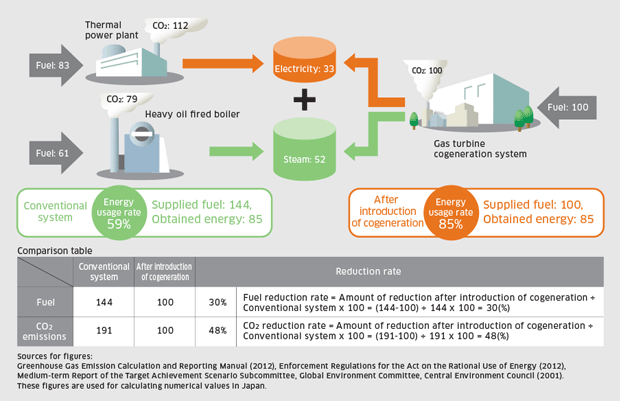
Example comparing economy of a conventional energy system and cogeneration system
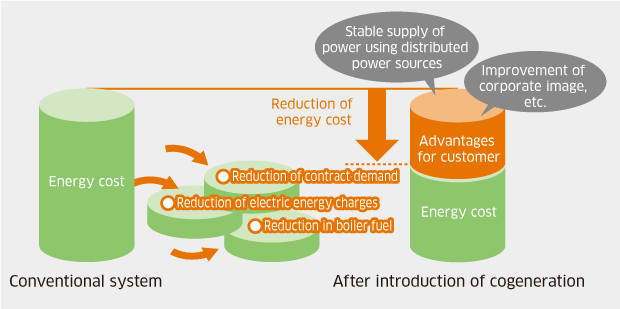
Kawasaki GPB Series
Kawasaki GPB Series is designed for base load applications, for both parallel operation with the grid and island mode operation. In addition, the Kawasaki GPB Series is able to operate in Cogeneration service, with automatic operation capability supplying both electricity and heat (steam, hot water, direct heat) by collecting waste heat with a heat recovery steam generator (HRSG), heat exchanger, or dryer, and in combined cycle with a steam turbine generator. With high total thermal efficiency, Kawasaki GPB series is capable of very efficient operation.
Features of Kawasaki Gas Turbines
Drive source is a 100% Japanese-made gas turbine.
We develop, design and fabricate our gas turbines in house, so there are no "black boxes." For more than 30 years since our first delivery, Kawasaki has been a pioneering manufacturer of gas turbine cogeneration systems.
We show advanced technology for environmental measures.
Due to the use of a DLE (Dry Low Emission) combustor, the system has a NOx value lower than the regulatory NOx emission levels established in many regions.
The extensive track record as a pioneering manufacturer.
We delivered Japan's first cogeneration system with a Japanese-made gas turbine, and we boast one of the most extensive track records world-wide with over 700 systems delivered.
The system is suitable for standby power generation too.
By using a dual-fuel system enabling use of both gas and liquid fuels, the system can carry out a black-out start with liquid fuel in case of power outage. (Normally, gas turbine generator sets are operated with gas fuel).
After-sales service is worry-free.
We provide comprehensive after-sales service through an extensive world-wide service network. We can supply parts and carry out maintenance in a short time.
Various types of fuels can be handled
The combustion technology in Kawasaki gas turbines is progressing with the state-of-the-art. Various types of fuels can be handled, including urban gas, natural gas, LPG, kerosene, diesel and fuel oil A. Please consult with us regarding special fuels that have not been used yet.
Product Lineup
Kawasaki offers a wide range of gas turbines to meet diverse needs.

| Engine Series | M1A Gas Turbine Series | |||||
|---|---|---|---|---|---|---|
| Gas Turbine Model | M1A-13A | M1A-13D | M1A-17 | M1A-17D | M1T-13A | M1T-13D |
| Gas Turbine Generator Model | GPB15 | GPB15D | GPB17 | GPB17D | GPB30 | GPB30D |
| Electric Output kW |
1,450 | 1,450 | 1,755 | 1,755 | 2,850 | 2,850 |
| Heat Rate kJ/kWe-hr |
15,130 | 15,280 | 13,120 | 13,120 | 15,350 | 15,510 |
| Exhaust Gas Temperature ℃ |
524 | 534 | 526 | 526 | 523 | 534 |
| Exhaust Gas Mass Flow x103 kg/hr |
28.8 | 28.5 | 28.8 | 28.8 | 57.6 | 57 |
| HRSG Steam Output x103 kg/hr |
5 | 5.1 | 5 | 5 | 9.9 | 10.2 |
| Total Thermal Efficiency % |
79.2 | 79.7 | 80.4 | 80.4 | 78.8 | 79.3 |
| NOx (02 : 15%) ppm |
- | 25 | - | 9*/15 | - | 25 |
| Approximate Package Dimension (L,W,H) m |
5.3 x 1.7 x 2.4 | 6.0 x 1.9 x 2.6 | 6.0 x 2.4 x 2.4 | |||
| Approximate Package Weight (dry) x103 kg |
14 | 14 | 21 | |||

| Engine Series | M5A Gas Turbine Series |
|---|---|
| Gas Turbine Model | M5A-01 |
| Gas Turbine Generator Model | GPB50D |
| Electric Output kW |
4,715 |
| Heat Rate kJ/kWe-hr |
11,100 |
| Exhaust Gas Temperature ℃ |
516 |
| Exhaust Gas Mass Flow x103 kg/hr |
62.6 |
| HRSG Steam Output x103 kg/hr |
10.6 |
| Total Thermal Efficiency % |
81.8 |
| NOx (02 : 15%) ppm |
15 |
| Approximate Package Dimension (L,W,H) m |
8.7 x 2.4 x 3.5 |
| Approximate Package Weight (dry) x103 kg |
41 |

| Engine Series | M7A Gas Turbine Series | |||||
|---|---|---|---|---|---|---|
| Gas Turbine Model | M7A-01 | M7A-01D | M7A-02 | M7A-02D | M7A-03 | M7A-03D |
| Gas Turbine Generator Model | GPB60 | GPB60D | GPB70 | GPB70D | GPB80 | GPB80D |
| Electric Output kW |
5,410 | 5,280 | 6,590 | 6,530 | 7,660 | 7,660 |
| Heat Rate kJ/kWe-hr |
12,300 | 12,460 | 12,070 | 12,090 | 10,830 | 10,830 |
| Exhaust Gas Temperature ℃ |
548 | 545 | 519 | 516 | 525 | 525 |
| Exhaust Gas Mass Flow x103 kg/hr |
77.6 | 77.6 | 95.8 | 95.8 | 97.3 | 97.3 |
| HRSG Steam Output x103 kg/hr |
14.5 | 14.4 | 16.4 | 16.2 | 17 | 17 |
| Total Thermal Efficiency % |
82.5 | 82.3 | 80 | 79.8 | 83.1 | 83.1 |
| NOx (02 : 15%) ppm |
- | 35 | - | 25 | - | 9.9/15 |
| Approximate Package Dimension (L,W,H) m |
11 x 2.6 x 3.7 | |||||
| Approximate Package Weight (dry) x103 kg |
55 | 58 | 58 | |||

| Engine Series | L20A Gas Turbine Series | L30A Gas Turbine Series |
|---|---|---|
| Gas Turbine Model | L20A | L30A |
| Gas Turbine Generator Model | GPB180D | GPB300D |
| Electric Output kW |
17,970 | 32,360 |
| Heat Rate kJ/kWe-hr |
10,690 | 9,110 |
| Exhaust Gas Temperature ℃ |
545 | 519 |
| Exhaust Gas Mass Flow x103 kg/hr |
213 | 315.8 |
| HRSG Steam Output x103 kg/hr |
39.7 | 54.1 |
| Total Thermal Efficiency % |
84 | 84.3 |
| NOx (02 : 15%) ppm |
15 | 15 |
| Approximate Package Dimension (L,W,H) m |
17.4 x 3.5 x 3.4 | 14.2 x 4.5 x 5.3 |
| Approximate Package Weight (dry) x103 kg |
143 | 155 |
[Nominal Performance]
Elevation 0m, Inlet air temperature 15℃, Inlet air pressure loss 0.98kPa, Exhaust gas pressure loss 2.45kPa(GPB15,15D,17,17D,30,30D,60,60D) 3.43kPa(GPB70,70D,180,180D,300,300D) 2.94kPa(GPB50D, 80, 80D) , LHV of Natural Gas Fuel(100% CH4) 35.9MJ/Nm3
[Typical Steam Condition]
Steam pressure 0.83MPaG, Steam temperature(saturated) 177℃, Feed water temperature 80℃, Blowdown from HRSG 0%
*Option
Note: Mark "D" means Dry Low Emission
Delivery Examples

- Model: GPB80D
- Country: Belgium
- Industry: Chemical
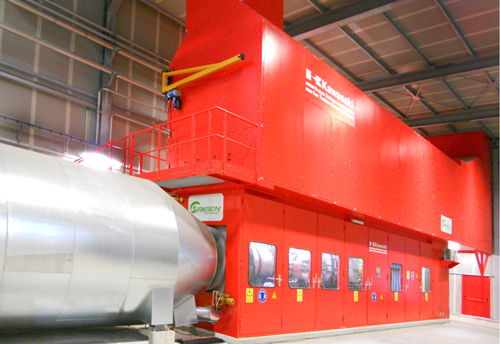
- Model: GPB80D
- Country: Italy
- Industry: Food
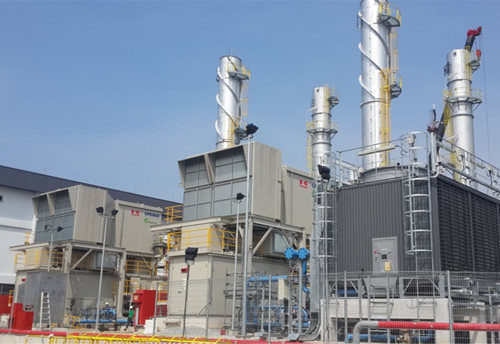
- Model: GPB180D
- Country: Malaysia
- Industry: Chemical
Brochure -Gas Turbine-
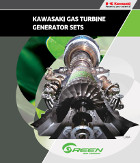
Kawasaki Gas Turbine Generator Sets
- Download(4.82MB)

Project K: Creating the World's Most Efficient Gas Turbine
Inside K: Gas Turbine Division, Akashi / Seishin Works
Contact
If you need more information about our business,
please feel free to contact us.





